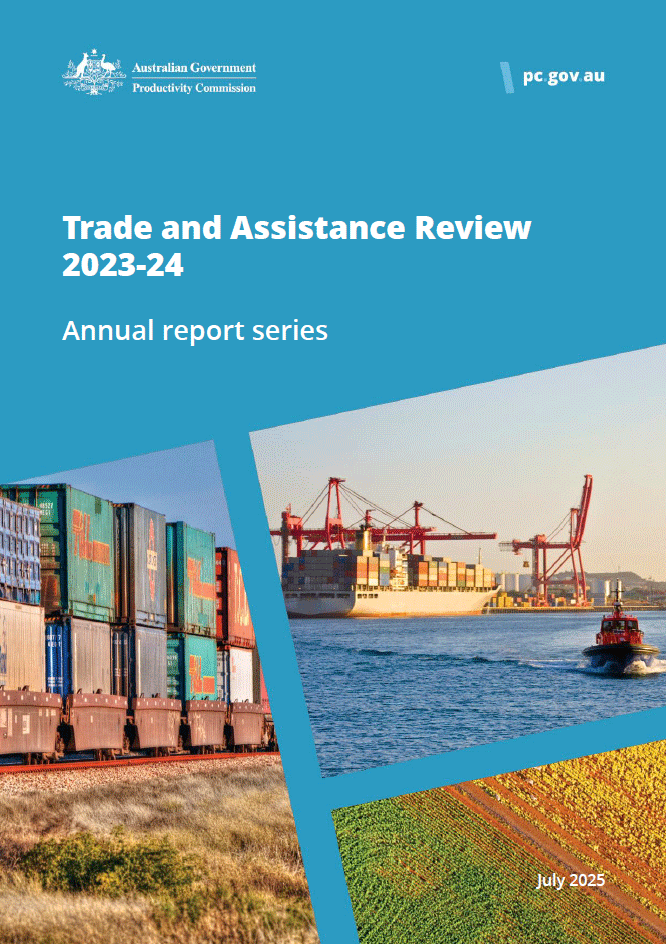Trade and Assistance Review 2023-24

Annual report series
Released 07 / 07 / 2025
The Trade and Assistance Review (TAR) contains the Commission’s latest estimates of Australian Government assistance to industry, and provides a summary of developments in industry assistance, trade policy and foreign investment over the past year.

Reform not retaliation the best approach to tariffs — Trade and Assistance Review 2023-24
New modelling shows that proposed US trade policy measures will have a marginal direct impact on the Australian economy, but the risks and uncertainty they have brought about may have far reaching costs.
The Trade and Assistance Review (TAR), the Productivity Commission’s annual report on developments in Australian trade and industry assistance policies, finds that continuing to advocate for free and open trade and looking for opportunities to lower our tariffs would be our best responses to changes in global trade policy.
“Australia’s prosperity has been built on free and open trade. The proposed tariffs are likely to have a relatively small direct effect on us, but the global uncertainty they’ve brought about could affect living standards in Australia and around the world,” said Deputy Chair Dr Alex Robson.
“Uncertainty is a handbrake on investment – when businesses are uncertain about the future, they are less likely to invest,” said Dr Robson.
The changes in tariff policy also carry broader risks.
“Further retaliatory escalation could spiral into a broader trade war, which would bring serious consequences for Australia and the world,” said Dr Robson.
“Australia can promote long-term economic stability by continuing to talk the talk – and walk the walk – on free and open trade,” said Dr Robson.
The modelling shows that (omitting the impact of uncertainty) the proposed US tariff changes could have a small, positive effect on Australia’s economy. The results suggest that cheaper imports from the rest of the world, and an outflow of productive capital from the US and highly tariffed economies, would slightly increase Australian production.
For example, US ‘Liberation Day’ tariffs and tariffs on aluminium, steel and automobiles and parts could lead to an increase in Australian real GDP of 0.37%.
The report also finds that imposing retaliatory tariffs would lead to worse economic outcomes for Australia, and that our best response would be to continue to remove existing tariffs.
The Government has already taken action to remove 457 nuisance tariffs, and this TAR identifies a further 315 ‘urgent priority’ tariffs which impose a high compliance burden and generate little policy or revenue benefit.
The report also looks at the growing role of industry policy in the Australian economy, particularly through the Australian Government’s Future Made in Australia agenda.
“While well-designed industry policy can offer benefits, when poorly designed it can be costly for governments, act as a form of trade protection and distort the allocation of Australia’s resources. This underscores the critical need for transparency, ongoing evaluation and review and clear exit strategies,” said Commissioner Catherine de Fontenay.
Media requests
Media team – 02 6240 3330 / media@pc.gov.au
- Preliminaries: Cover, Copyright and publication detail, Foreword, Contents, Acknowledgements and disclosure of interests
- Executive summary
- 1. International trade policy developments
- 1.1 The international trade environment has deteriorated
- 1.2 Growing uncertainty will have negative consequences of its own
- 2. Australian trade policy developments
- 2.1 Australia has a long history of trade liberalisation
- 2.2 Australia’s trade agreements, disputes and relationships
- 2.3 Australia continues to have many nuisance tariffs
- 2.4 Prospects for further unilateral trade liberalisation
- 3. Australian industry assistance developments
- 3.1 Future Made in Australia’s rationale and risks
- 3.2 Decomposing FMIA’s spending profile
- 4. Australian industry assistance estimates for 2023-24
- 4.1 A look at budgetary assistance in 2023-24
- 4.2 A look at concessional finance in 2023-24
- 5. Australian foreign investment policy developments
- 5.1 Changes to foreign investment policy
- 5.2 Foreign direct investment applications
- 5.3 Trends in foreign investment
- Appendices
- A. Modelling the impact of global tariffs
- B. Assistance estimates
- C. Literature review on trade agreement compliance costs
- Abbreviations
- References
Printed copies of this report can be purchased from Canprint Communications.
We value your comments about this publication and encourage you to provide feedback.

